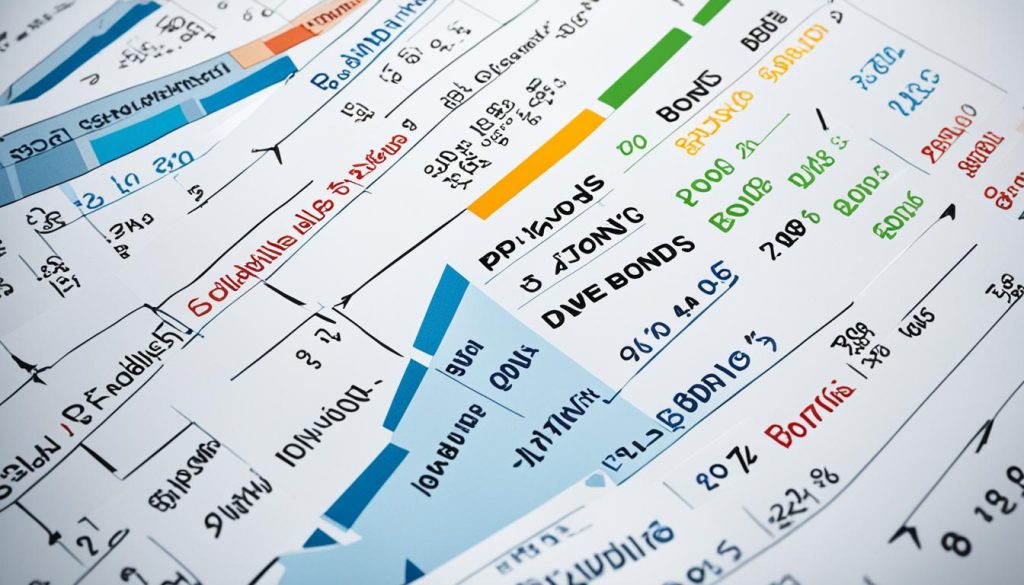Exploring bond investments might seem tough, but this guide aims to make it easier. It’s for both new and experienced investors. We’ll cover the basics of bonds, their types, risks, and benefits. This will help you understand how to add bonds to your investment mix1.
Bonds are like loans where investors lend money to governments or companies. They get back their money plus interest, known as the coupon. This makes bonds a good choice for those wanting steady income and to keep their money safe2.
Key Takeaways
- Bonds give a steady income with regular interest payments, offering a dependable cash flow.
- Buying individual bonds usually needs a bigger upfront investment than bond funds. But, it gives you more control and clarity over your investments.
- Bonds add variety to your investments, reducing the risk from stocks.
- It’s important to know about the different bonds, their features, and risks to make a good investment plan.
- Creating a solid bond investment plan that fits your financial goals and risk level is key to success in bond investing.
Bonds: An Introduction to Fixed Income Investments
Bonds are key in the fixed income market. They let investors lend money to governments, cities, or companies. In return, they get regular interest and their money back at the bond’s end3. It’s important to know how bonds work to invest wisely in this area.
What is a Bond?
A bond is a type of debt security. It means an investor lends money to a government, city, or company4. The borrower pays back the investor with interest, called the coupon, and the full loan amount at a set date3.
How Bonds Work: Coupons, Yields, and Maturity
Bonds can have fixed or floating interest rates. Their yield comes from the coupon and the market price3. They also have a maturity date, when the full loan must be paid back. If not, the borrower could default3.
Most bonds start at par, costing $1,000 each3. But, their prices can change over time. This depends on the borrower’s credit, time left until maturity, and interest rates3. Investors can sell bonds for a gain or loss, based on the market.
“Understanding the fundamentals of how bonds work, including coupons, yields, and maturity, is crucial for navigating the fixed income market.” –3
There are four main types of bonds: corporate, municipal, government, and agency bonds34. Each has its own risks and benefits. Knowing about these can help investors choose the right bonds for their portfolios.
Types of Bonds and Their Characteristics
There are many types of bond investments, each with its own features and risks. Knowing the differences helps you make better choices and diversify your portfolio.
Government Bonds: Treasuries and Municipal Bonds
Government bonds, like U.S. Treasuries, are seen as safe because of the government’s stability. They come with terms of 10, 20, or 30 years5. International government bonds offer a way to diversify your portfolio but come with risks like political issues and currency changes5. Municipal bonds, or “munis,” give you tax-free interest income at the federal, state, and sometimes local levels5.
Corporate Bonds: Investment-Grade and High-Yield
Corporate bonds are split into investment-grade and high-yield types. Investment-grade bonds have high credit ratings, meaning they’re less likely to default6. They might offer lower returns than high-yield bonds. High-yield bonds give higher interest rates to match their higher risk6.
Mortgage-Backed Securities and Agency Bonds
Mortgage-backed securities (MBS) are backed by mortgage loans. Agency bonds are from government-backed companies like Fannie Mae and Freddie Mac. Even though not directly backed by the government, they’re very safe and often have higher returns than Treasuries5. Green bonds fund projects that help the environment and support sustainability5.
Bond ETFs offer a way to invest in many bonds at once. They’re easy to buy and sell, clear on price, and have lower investment costs. But, they still face risks from interest rates and credit issues5.
| Bond Type | Minimum Investment | Risk Profile | Tax Treatment |
|---|---|---|---|
| U.S. Government Bonds and Securities | $100 through Treasury Direct or a broker | Low risk | Interest income exempt from state and local taxes |
| Municipal Bonds (“Munis”) | $5,000 minimum through a broker | Low to medium risk | Interest income exempt from federal, state, and sometimes local taxes |
| Corporate Bonds | No minimum through a broker with $0 fees per online equity trade | Medium to high risk, depending on credit quality | Taxable interest income |
| Agency Securities | $10,000 minimum | Low risk due to government affiliation | Interest income exempt from state and local taxes |
| International and Emerging Market Bonds | Varies | Medium to high risk due to sovereign and currency risks | Taxable interest income |
| Bond ETFs | No minimum | Medium risk, subject to interest rate and credit risk | Taxable distributions, but may provide tax advantages |
The bond market has many options, each with its own risk and benefits. By understanding government, corporate, mortgage-backed, and other bond types, you can create a portfolio that meets your financial goals and risk level576.
bond investments, fixed income, bond market
Bonds are key for diversifying your portfolio and getting a steady income. The bond market has many options, each with its own risks and benefits. It’s important to know about these options if you want to add fixed income investments to your financial plan.
Treasury bonds are a popular choice for fixed-income investments. They include Treasury bills (T-bills), Treasury notes (T-notes), and Treasury bonds (T-bonds). T-bills are short-term and don’t pay interest. T-notes pay interest every six months and last between two and 10 years. T-bonds last 20 or 30 years and can be bought in $100 amounts. Treasury Inflation-Protected Securities (TIPS) adjust their value with inflation, making them a good choice against inflation.
Corporate bonds are issued by companies and have different prices and interest rates based on the company’s financial health. Junk bonds offer higher interest but come with a higher risk of not being paid back. Certificates of deposit (CDs) are also fixed-income options with terms under five years and often higher interest rates than savings accounts.
| Bond Type | Maturity | Coupon Payments | Key Characteristics |
|---|---|---|---|
| Treasury Bills (T-Bills) | 1 year or less | None | Short-term, no coupon payments8 |
| Treasury Notes (T-Notes) | 2-10 years | Fixed, semiannual | Medium-term, fixed interest rate8 |
| Treasury Bonds (T-Bonds) | 20-30 years | Fixed, semiannual | Long-term, fixed interest rate, $100 multiples8 |
| Treasury Inflation-Protected Securities (TIPS) | Varies | Fixed, semiannual | Adjusts principal with inflation and deflation8 |
| Corporate Bonds | Varies | Fixed, semiannual | Issued by companies, prices depend on creditworthiness8 |
| Junk Bonds | Varies | Higher coupons | High-yield bonds with higher default risk8 |
| Certificates of Deposit (CDs) | Less than 5 years | Fixed | Higher rates than savings accounts8 |
Understanding the different types of bonds helps investors make smart choices for their fixed income investments. Whether you want steady income, diversification, or to preserve capital, the bond market has options for you.

“The bond market is volatile, with fixed income securities carrying various risks including interest rate risk, inflation risk, liquidity risk, call risk, and credit and default risks.”9
It’s important to research and understand the risks of bond investing before making decisions. By knowing the unique features of different bonds, investors can confidently navigate the bond market and improve their investment portfolio’s performance.
Risks Associated with Bond Investing
Bonds are seen as a safer investment than stocks, but they still carry risks. It’s important for investors to know these risks to make smart choices and manage their money well.
Interest Rate Risk and Bond Price Fluctuations
Interest rate risk is a big concern in bond investing. When interest rates go up, bond prices go down, and vice versa.10 This happens because new bonds with higher rates become more appealing, making older bonds with lower rates less valuable10. It’s key for investors to understand this risk to protect their investments.
Credit Risk and Default Potential
Credit risk is another big risk in bonds. Bonds are rated by agencies like Moody’s and S&P, from top quality (Aaa or AAA) to default (D).11 Lower-rated “junk” bonds might be riskier but could also offer higher returns11. Investors should look closely at the credit of bond issuers and spread out their investments to reduce this risk.
| Risk Type | Definition | Potential Impact |
|---|---|---|
| Interest Rate Risk | Inverse relationship between bond prices and interest rates | Existing bond values typically drop when market interest rates rise10 |
| Credit Risk | Risk of bond issuer defaulting on payments | Decrease in market value and potential loss of investment11 |
| Liquidity Risk | Ability to sell a bond may vary due to changes in supply, demand, and market conditions | Difficulty in selling the bond at a favorable price11 |
| Reinvestment Risk | Timing of reinvestment can affect returns, impacting investors in different interest rate environments | Potential loss of income or principal when reinvesting at lower rates11 |
Knowing these risks and how to handle them helps investors do better in the bond market. This way, they can make choices that help them reach their financial goals.

Benefits of Investing in Bonds
Investing in bonds is smart for many reasons. They add balance to your investment mix, helping to smooth out the ups and downs of stocks12. They also offer a steady income through regular interest, which is great for those who want predictable money coming in12. Plus, bonds are known for keeping your money safe, returning your principal at the end, making them a solid choice12.
Diversification and Portfolio Balance
Bonds are key for diversifying your investments. They’re less volatile than stocks, which helps balance your portfolio12. This balance lowers the risk of your investments, spreading them out across different types12.
Steady Income and Capital Preservation
Bonds are great for steady income. They usually have higher interest rates than savings accounts or CDs12. This regular income is attractive for those who need a dependable cash flow13. Bonds also tend to keep your money safe, returning the principal at the end, which is a conservative choice12.
| Investor Age | Suggested Bond Allocation |
|---|---|
| 30 years old | 20% in bonds and cash |
| 65 years old | 65% in bonds and cash |
The right bond allocation depends on your investment goals, risk comfort, and financial situation12. As you get closer to retirement, bonds become even more important for keeping your money safe14.
“Bonds can provide a reliable income stream and a level of capital preservation, making them a valuable addition to any investment portfolio.”
By choosing bonds, you can make your portfolio more diverse, earn steady income, and protect your capital. These benefits can help you achieve your financial goals in the long run121314.
Building a Bond Portfolio: Strategies and Considerations
Creating a strong bond portfolio means thinking about your goals, how much risk you can handle, and the market’s state. Spread your bond investments across different types, maturities, and credit qualities to manage risk and boost returns15. Keep an eye on interest rates and inflation when managing your bond portfolio15.
There are various bond investing strategies to consider15. One way is passive investing, where you buy bonds and hold them until they mature to earn income15. Bond laddering is another strategy, dividing your portfolio into parts with bonds maturing at different times15. On the other hand, active management tries to increase your total return but also increases risk15.
Immunization matches your assets and liabilities’ durations to shield against interest rate changes, which is good in unstable markets15. Indexation tracks a bond market index, offering diversification and steady returns15.
When building your bond portfolio diversification, mix in different bond types like government, corporate, and mortgage-backed securities15. This mix can help you manage risk and improve your investment results15.
| Bond Portfolio Strategies | Key Characteristics |
|---|---|
| Passive Investing | Purchasing individual bonds and holding them to maturity to maximize income15 |
| Active Management | Aiming to maximize total return, but with increased risk15 |
| Immunization | Matching the durations of assets and liabilities to protect against interest rate fluctuations15 |
| Indexation | Tracking a bond market index, providing diversification and potential for steady returns15 |
Building a strong bond portfolio needs careful thought on your goals, risk tolerance, and market trends. A balanced approach and diversifying your bonds can make your investment portfolio more stable and successful15.
Conclusion
This guide has shown how bonds can be a key part of your investment plan. They offer steady income, help diversify your investments, and protect your capital16. By learning about the different types of bonds and their risks, you can make smart choices in the fixed income market17.
If you’re new to bond investing or want to improve your current strategy, this guide has given you the tools you need. It covers important topics like interest rate risk, credit risk, and diversification. This way, you can build a bond portfolio that fits your risk level and goals16.
Remember, the bond market is always changing18. It’s important to stay updated, watch market trends, and adjust your strategy when needed. With these steps, you can confidently navigate the bond market and reach your financial goals. Using what you’ve learned about bond investments can boost your portfolio’s strength.
FAQ
What are bonds?
Bonds are debt securities. They let investors lend money to governments, cities, or companies. In return, they get regular interest and their money back at the bond’s end.
How do bonds work in terms of coupons, yields, and maturity?
Bonds pay out interest, called coupons, which can be fixed or change. The bond’s yield comes from the coupon and its price. Knowing about coupons, yields, and maturity is key for investing in bonds.
What are the different types of bonds and their characteristics?
There are many types of bonds, like government, corporate, and mortgage-backed securities. Each has its own risks and rewards. Understanding these differences is important for investors.
What are the risks associated with bond investing?
Bond investing comes with risks like interest rate risk and credit risk. Interest rate risk means bond prices go down when rates rise. Credit risk is the chance a bond issuer won’t pay back what they owe.
What are the benefits of investing in bonds?
Bonds offer diversification, steady income, and capital preservation. They help balance the ups and downs of stocks and other investments. Bonds also provide regular interest and return the principal at maturity.
How can you build an effective bond portfolio?
To build a strong bond portfolio, think about your goals, how much risk you can take, and the market. Diversifying across different bond types and maturities can help manage risk and improve returns.
Source Links
- How to invest in bonds | Bonds vs. bond funds | Fidelity
- Bonds
- Bonds: How They Work and How To Invest
- Everything You Need to Know About Bonds | PIMCO
- Types of Bonds and How They Work
- Bonds | Investor.gov
- Types of Bonds to Know About – NerdWallet
- Guide to Fixed Income: Types and How to Invest
- Fixed income & bonds | Investment account options | Fidelity
- Understanding Bonds: Risks and Types of Bond Investments
- Risks of Bond Investing – Fixed Income
- Some of the Advantages of Bonds
- Bonds vs. Bond Funds: Which Is Right for You?
- The Pros and Cons of Buying Bonds – Experian
- Top 4 Strategies for Managing a Bond Portfolio
- Bond Market Outlook: Improving Returns | Morgan Stanley
- 4 Basic Things to Know About Bonds
- 2024 Systematic Fixed Income Outlook | BlackRock

